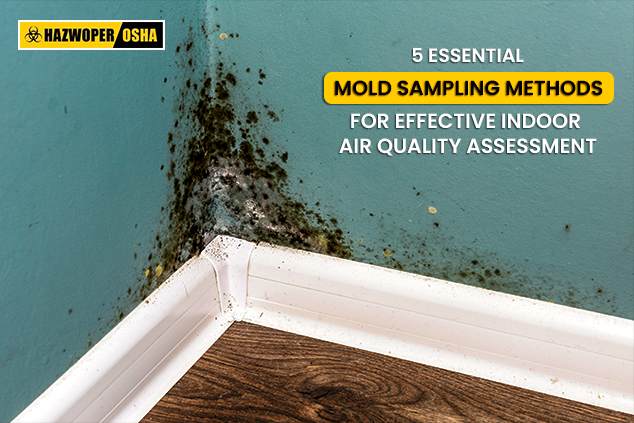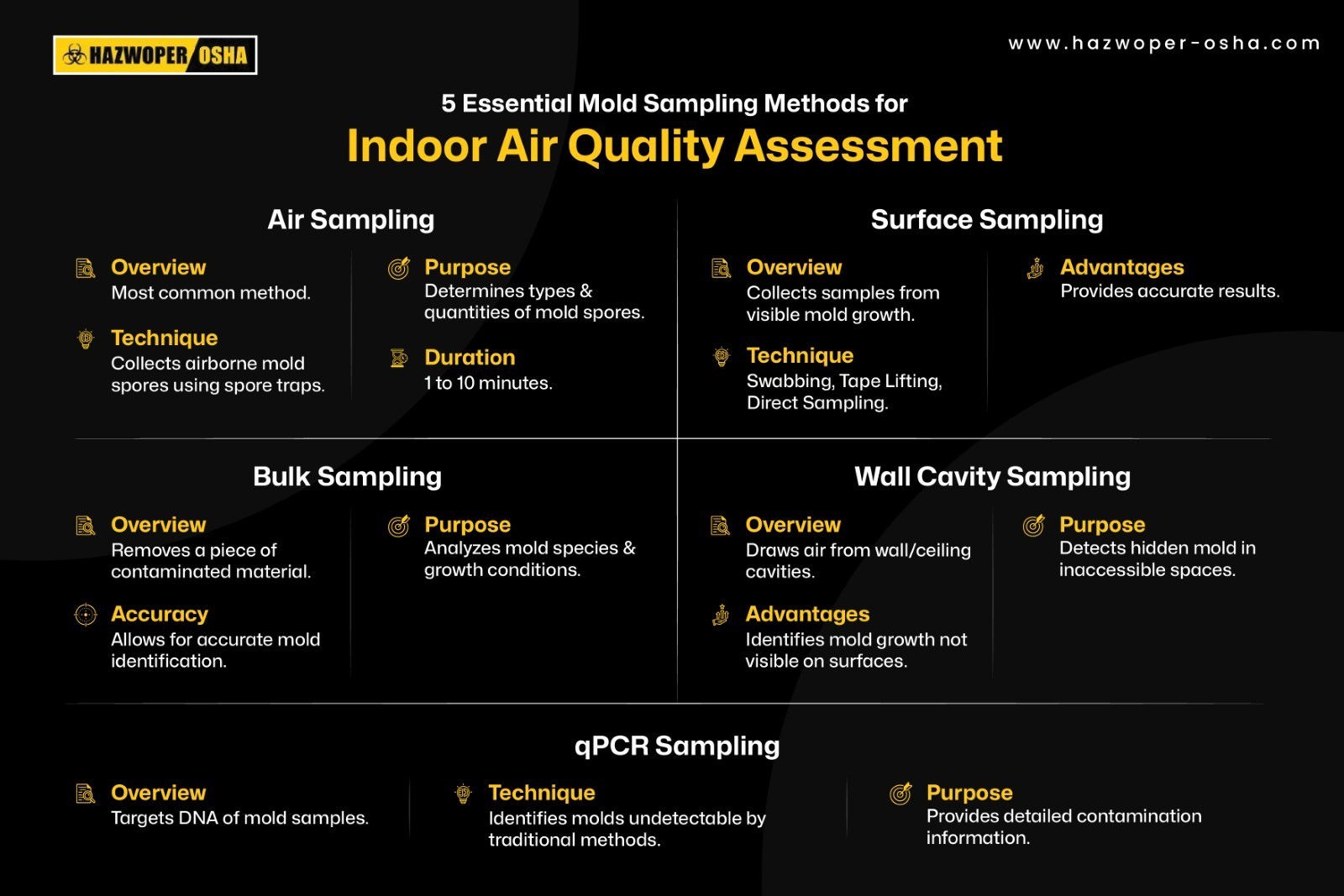5 Essential Mold Sampling Methods for Effective Indoor Air Quality Assessment

Introduction:
A healthy indoor environment is necessary for human well-being. Poor indoor air quality is a major cause of various respiratory and health issues. That is why a detailed indoor air quality assessment is required to identify health risks. Indoor air quality assessment includes mold sampling and accurately detecting and identifying mold species growing indoors. This article will explain the different types of mold sampling methods and the factors that affect the selection of a particular type of mold sampling. It will also highlight how to interpret mold sampling results.
Why Indoor Air Quality Assessment is Vital?
The indoor air quality assessment helps to identify, address & mitigate the issues that affect the air quality at an indoor facility. It in turn ensures a safe and healthy environment for the occupants. Poor indoor air quality impacts health negatively, causing asthma and allergic reactions, along with more chronic medical issues such as lung cancer and cognitive deficits. Mold sampling is one of the crucial testing procedures in indoor air quality sampling as it accurately detects and identifies the mold species and their concentrations. This information is vital to creating the remediation plan and effectively addressing the problem.
The most common types of molds found in households include Penicillium, Cladosporium, and Aspergillus. These types of molds grow well in damp or moisture-rich surroundings, such as environments with high humidity, water leaks, and poor ventilation. Apart from walls and ceilings, mold also grows on different surfaces such as carpets, wood, paper, and insulation and releases their spores, which are inhaled by the residents.

Caption: Commonly found mold species in mold species in indoors.
How Indoor Air-Quality Assessment Test Works?
The indoor air quality assessment is used to identify potential sources of moisture and molds by visual inspection of the facility, followed by air and surface sampling to determine the concentration and types of mold present.
Following are the general steps of an effective indoor air quality assessment process:
- A preliminary walk-through of the establishment identifies potential air contamination sources, including chemicals, molds, and deficient ventilation.
- The next step is air sampling, where air is collected from different locations within the facility to calculate the levels of particulate matter, volatile organic compounds, carbon dioxide, and other harmful substances.
- Data analysis compares the collected samples against the established safety and health standards.
- The report's results are outlined, including possible health risks and actions to improve air quality. The steps to improve air quality include better ventilation, the use of air purification systems, and the removal of pollution sources.
Homeowners and building managers rely on this indoor air quality assessment test to implement measures to maintain a healthy indoor environment and prevent people from health issues from mold exposure.
5 Effective Types of Molds Sampling Methods
Mold sampling techniques differ according to the types of environments and the species. These are the common types of mold sampling methods:
- Air Sampling:
The most common method for studying indoor air environments is air sampling. This method includes collecting air samples by using specialized equipment, such as spore traps, that pull-out air through a filter to catch mold spores. This method is helpful for assessing the types and quantities of airborne mold spores, which depict the extent of contamination and possible health risks. The air sampling duration differs according to the environmental conditions, with the average durations varying from 1 to 10 minutes. - Surface Sampling:
Focuses on collecting samples from the surface of materials where mold is visible. Techniques include swabbing, tape lifting, and direct sampling with a sterile tool. - Bulk Sampling:
Here, a small chunk of material is collected for the analysis. This method is preferred as it provides the most accurate identification of mold species and growth conditions. From the bulk material, a representative sample is taken and cultured for species identification. In this method, the mold genus can be identified using direct microscopy. - Wall Cavity Sampling:
This method includes drawing air from the cavities within the walls or ceilings to confirm the mold spore's presence. The wall cavity sampling method detects hidden mold sources in the out-of-reach spaces by identifying mold growth that is not evident from the surface. - qPCR (Quantitative Polymerase Chain Reaction) Sampling:
This specialized method targets the DNA of mold spores. It is especially useful for mold identification, which is hard to detect through traditional methods. This method collects the samples and analyzes them using DNA-based tests, identifying a wide range of mold species that provide even more in-depth information regarding the extent of contamination.
All five methods are important in detailed mold inspection. Professional mold inspectors use these methods to determine the presence, type, and quantities of mold and devise effective remediation strategies.

Caption: 5 Necessary methods of Mold Sampling for Indoor Air Quality Assessment.
Which Factors Influence the Mold Sampling Method Selection?
The selection of the most appropriate sampling method is vital to ensure accurate and reliable results of mold assessment. Following are the factors that are taken into account while choosing the mold sampling method selection:
Types of Molds Suspected:
The sampling method is influenced by the mold type suspected in indoor space. Various mold species have differing growth patterns, favored environmental conditions and spore characteristics. As an example, airborne mold spores can be effectively detected by the air sampling method, while visible mold growth is identified by surface sampling easily. The professionals can choose the most suitable sampling technique if they know the suspected mold type to make sure the correct quantification and identification.
Environment and Location:
The mold sampling method is also determined by the physical environment where the mold assessment is conducted. Ventilation, moisture levels, and the HVAC system's presence impact mold spores' distribution and concentration.
The wall cavity sampling may be essential to detect the hidden mold growth in spaces with high moisture or restricted airflow. In contrast, air sampling captures the airborne mold spores more effectively in well-ventilated areas. In addition, the condition and the accessibility of the sampling site also affect the method chosen. In some scenarios, bulk sampling techniques are preferred to better understand mold contamination, even if it requires a small amount of damage to the building materials.
By considering the mold type suspected and the environmental conditions of the sampling location, the professional can pick out the most suitable mold sampling methods to ensure the accuracy and reliability of the results, which are necessary for developing effective remediation strategies.
Sampling Purpose:
The mold sampling method is influenced by the goal of the mold sampling, whether it is for building inspection, health risk assessment, or regulatory compliance. To assess potential health risks, air sampling is mostly used to measure the spore levels of the airborne molds. Similarly, the presence of visible mold growth can be confirmed by surface sampling through tape lifts or swabs to identify the mold type. Certain situations require specific sampling types and protocols, such as post-remediation clearance testing.
How to Interpret Mold Levels After Sampling?
The severity of the mold problem and the appropriate remediation measures are planned after correctly interpreting the mold levels in the sampling results.
EPA states an indoor mold spore count of less than 500 spores/cubic meter (sp/m3) is usually considered a normal background level.
Concentrations higher than this indicates heightened levels that need more investigation and remediation. To prevent indoor sources of mold growth, the WHO advises that indoor mold levels should be lower than outdoor mold levels.
Mold species have varying sensitivity, and even low levels of some species, such as Stachybotrys chartarum, can be dangerous to human health. These risks are even more severe for people with allergies and respiratory conditions.
How Are We Helping?
Everyone deserves a healthy and safe indoor environment; that is why we, HAZWOPER OSHA Training LLC, have been providing workplace safety training and courses all over the USA. To help mold inspectors, we have created Mold Prevention and Remediation Awareness Training to provide a general overview of indoor mold prevention and remediation. A more comprehensive Mold Inspector Certification for Prevention, Remediation, and Removal Training is designed to meet the state-specific licensing requirements. To meet the needs of different employees and organizations, we offer these courses in SCORM, online, and Instructor-led formats. So don't wait! Enroll today and get certified.
The Wrap-Up:
Understanding, addressing, and maintaining indoor air quality is essential for maintaining a healthy living environment. By using effective mold sampling methods, we can identify and remediate mold issues that are significantly harming human health. Professional mold inspectors must know the usability of these tests and the interpretation of the results and ensure that mold levels are kept within safe limits. Homeowners and building managers can take steps to keep their indoor spaces healthy simply by understanding the mold types, sampling methods, and remediation strategies.
References:
Caltex Mold Services, Mold Sampling, http://www.caltexmoldservices.com:10000/section/mold_sampling//a>PEL Laboratoires, Different Types of Mold Sample Collection, https://www.pellabs.com/learn/asbestos/mold-analysis-ann-arbor-sample-collection
Occupational Safety and Health Administration, A Brief Guide to Mold in the Workplace, https://www.osha.gov/publications/shib101003

 EN |
EN |  ES
ES

























































































































